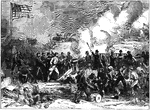Clipart tagged: ‘battleground’

Battleground near Fort Anne
Battleground near Fort Anne. This sketch was taken from the rail-road, looking north. The forest upon…

Battleground at Concord
"Battle ground at Concord. This view, looking southeast, is from the road leading to the village, by…

Hobkirk's Hill
"View at the Spring; Hobkirk's Hill. It is at the hed of a ravine, scooped out of the northeastern slope…

View at King's Mountain Battleground
The Battle of Kings Mountain, October 7, 1780, was an important Patriot victory in the Southern campaign…

Battleground at Monmouth
The Battle of Monmouth was an American Revolutionary War battle fought on June 28, 1778 in New Jersey.

Princeton battle-ground
"View of the battle-ground near Princeton. This view, looking north, is from the carriage gate of Mr.…
